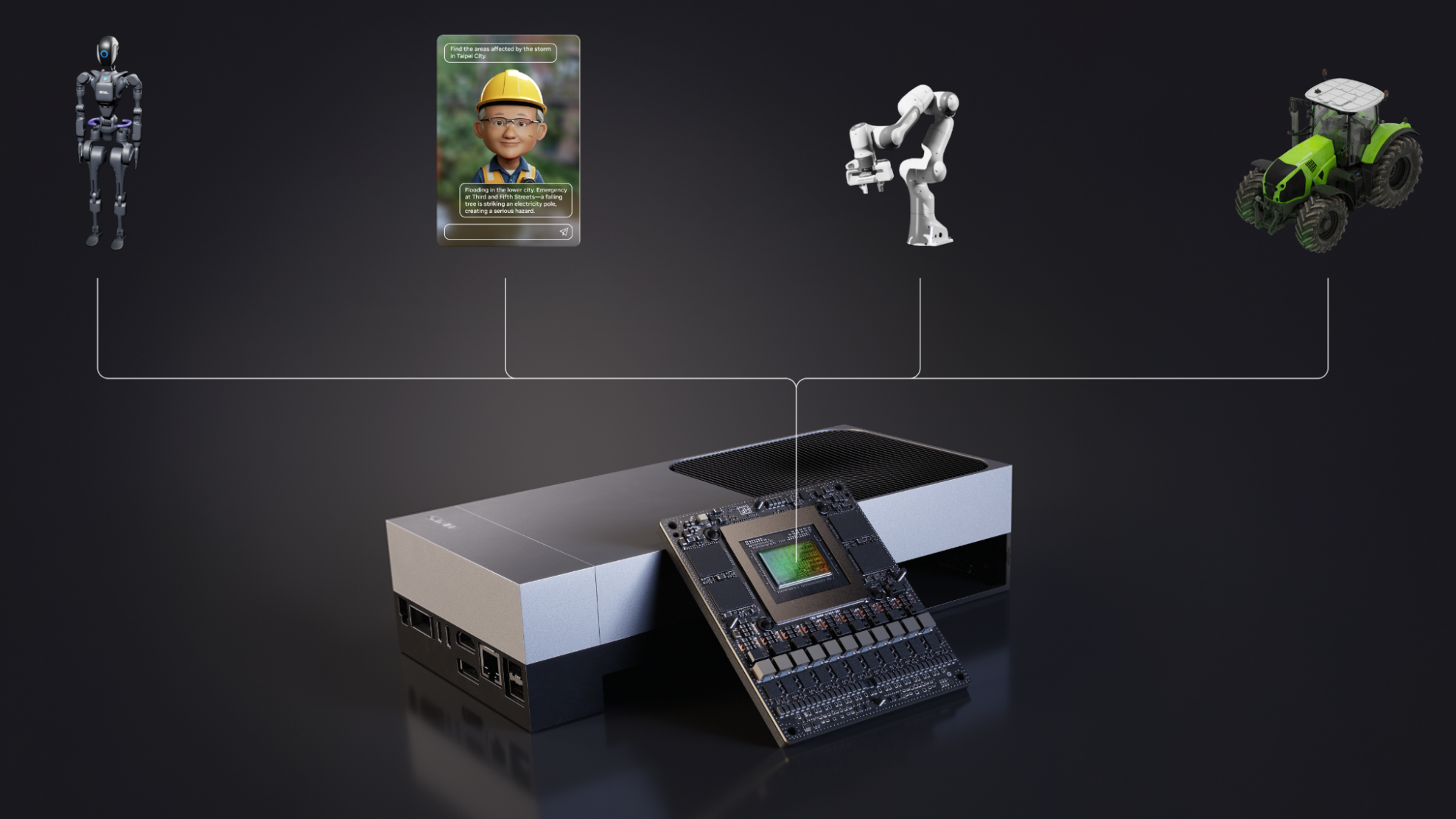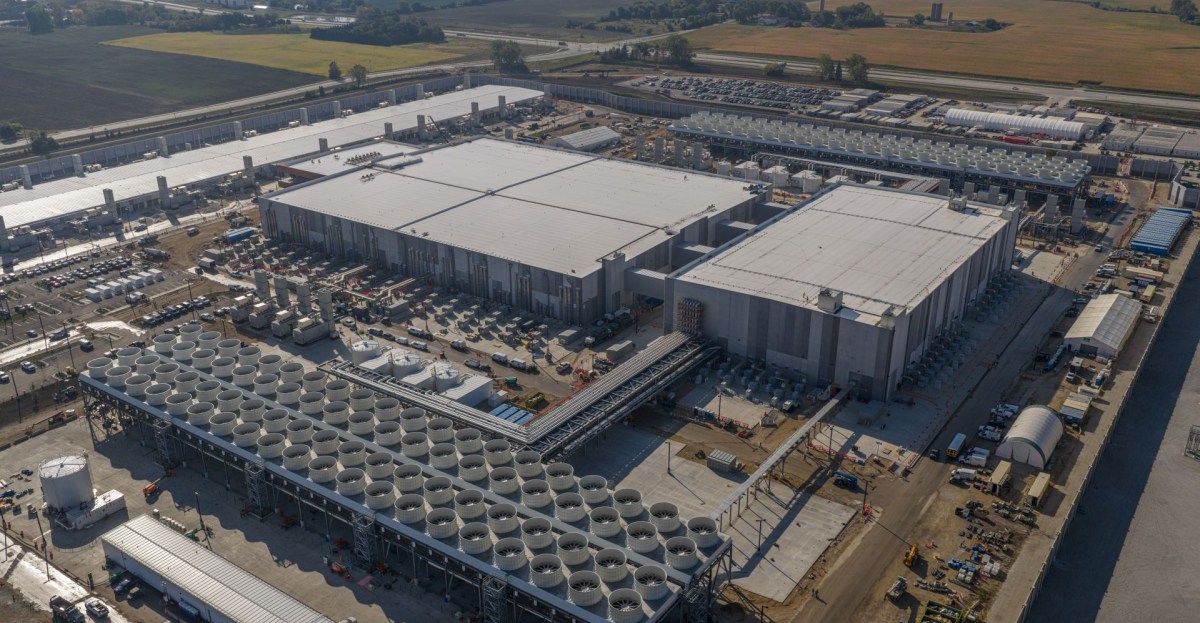
NVIDIA Jetson Thor: The Ultimate Platform for Physical AI
Sources: https://developer.nvidia.com/blog/introducing-nvidia-jetson-thor-the-ultimate-platform-for-physical-ai, https://developer.nvidia.com/blog/introducing-nvidia-jetson-thor-the-ultimate-platform-for-physical-ai/, NVIDIA Dev Blog
TL;DR
- NVIDIA unveils Jetson Thor, the ultimate platform for physical AI, combining a Blackwell GPU, 128 GB memory, and MIG for edge robotics.
- Delivers up to 7.5x higher AI compute and up to 3.5x better energy efficiency versus Jetson AGX Orin, with native FP4 quantization and a Transformer Engine that dynamically switches between FP4 and FP8.
- Supports multiple generative AI models at the edge (LLMs, VLMs, VLA models) and real-time, multi-sensor processing, with demonstrated forwarding of 16 simultaneous requests.
- The platform is completed by Jetson AGX Thor Developer Kit and Jetson T5000 module, JetPack 7, CUDA 13.0 for ARM, and software stacks including Isaac, Metropolis, and Holoscan.
- MIG, robust I/O (QSFP 4x25 GbE, RJ45, USB), and a 130 W envelope enable seamless prototyping for humanoid and autonomous robots.
Context and background
Robotics is undergoing a revolution toward generalist platforms that can learn, adapt, and operate across environments rather than being fixed-function. Inspired by human cognition, these robots rely on fast, reactive responses combined with higher-level planning to enable efficient learning and broad applicability. NVIDIA has framed this shift around the Isaac GR00T platform introduced at GTC 2025, bringing together robot foundations models, synthetic data pipelines, a simulation environment, and a runtime computer. Building on that foundation, Jetson Thor represents the edge-compute extension designed to accelerate foundation models and multimodal sensing for next-generation robots. Jetson Thor enables robots to be retooled for new tasks without reprogramming, supporting object manipulation, navigation, instruction following, and more at scale. For developers, this platform provides a cohesive, edge-optimized environment for deploying generative reasoning and sensor processing in real time. NVIDIA describes Jetson Thor as a giant leap in edge AI for physical robotics.
What’s new
Jetson Thor is anchored by two main products: the NVIDIA Jetson AGX Thor Developer Kit and the NVIDIA Jetson T5000 module. The kit is built to deliver unmatched performance and scalability for edge robotics, powered by the NVIDIA Blackwell GPU coupled with 128 GB of memory and a 130 W power envelope. It provides up to 2070 FP4 TFLOPS of AI compute to run cutting-edge generative AI models within a compact edge form factor. Relative to Jetson AGX Orin, Thor offers up to 7.5x higher AI compute and up to 3.5x better energy efficiency. The platform introduces native FP4 quantization with a next-generation Transformer Engine that dynamically switches between FP4 and FP8 to optimize performance for memory bandwidth and speed. Key hardware and software highlights include:
- A 14-core Arm Neoverse-V3AE CPU and a suite of accelerators, including a third-generation Programmable Vision Accelerator (PVA), dual encoders/decoders, and an optical flow accelerator.
- MIG (Multi-Instance GPU), enabling a single GPU to be partitioned into isolated instances with dedicated resources for predictable, mixed-critical workloads.
- Extensive I/O, including a QSFP slot with 4x25 GbE, a wired Multi-GbE RJ45 connector, multiple USB ports, and additional connectivity options for fast sensor integration.
- Compatibility with Humanoid robot platforms and easy tethering for rapid prototyping. On the software side, Jetson Thor runs the NVIDIA AI software stack for physical AI, including NVIDIA Isaac for robotics, NVIDIA Metropolis for visual agentic AI, and NVIDIA Holoscan for sensor processing. The platform supports a unified CUDA 13.0 installation across ARM targets, aligning with SBSA (Server Base System Architecture) for smoother enterprise integration. Jetson software is complemented by JetPack 7, Linux kernel 6.8, and Ubuntu 24.04 LTS, delivering a tightly integrated, real-time capable edge stack. NVIDIA provides detailed insights into these stack components and how they enable edge AI at scale.
Why it matters (impact for developers/enterprises)
Jetson Thor is designed to empower developers and enterprises to deploy flexible, edge-native AI agents that can reason across modalities and tasks without constant reprogramming. By accelerating foundation models at the edge, Thor enables robots to operate with high-level planning, robust perception, and responsive control in dynamic environments. This capability is particularly important for robotics in manufacturing, logistics, healthcare, and autonomous systems where real-time decisions and safety-critical performance are essential. The combination of hardware capabilities (FP4/FP8 acceleration, MIG, memory bandwidth) and software integration (Isaac, Metropolis, Holoscan, and edge AI workflows) creates a cohesive platform for building, testing, and deploying edge AI agents and robotic workflows. The platform’s demonstrated performance under real workloads—such as 16 simultaneous requests using Qwen2.5-VL-3B VLM and Llama 3.2 3B LLM with sub-200 ms TTFT and sub-50 ms TPOT—illustrates the practical responsiveness developers can expect in production environments. The ability to run multiple generative AI models at the edge, supported by a unified CUDA toolchain on ARM and robust hardware isolation via MIG, helps reduce latency, increase throughput, and improve reliability for mission-critical robotics applications. NVIDIA positions Jetson Thor as a vehicle to accelerate edge inference, cost-effective deployment, and end-to-end edge-to-cloud workflows for physical AI.
Technical details or Implementation
Jetson Thor is built around a new class of robotic computers engineered specifically for humanoid and autonomous robots. Some of the standout hardware and software details include:
- GPU and memory: NVIDIA Blackwell architecture with native FP4 support, 128 GB memory, and a 130 W power envelope, delivering up to 2070 FP4 TFLOPS of AI compute to run latest generative AI models.
- Processor and accelerators: 14-core Arm Neoverse-V3AE CPU, with a suite of accelerators including a third-generation PVA, dual encoders/decoders, and an optical flow accelerator to speed up perception and motion planning.
- Multimodal and model support: The platform is designed to handle a wide range of generative AI models, from vision-language-action (VLA) models like NVIDIA Isaac GR00T N1.5 to popular large language models (LLMs) and vision-language models (VLMs). The Cosmos Reason 7B VLM is supported for physical AI reasoning tasks.
- Quantization and inference techniques: Native FP4 quantization, with a dynamic Transformer Engine that switches between FP4 and FP8 to optimize accuracy and throughput. Speculative decoding further accelerates inference by proposing tokens with a smaller draft model that the larger model then validates.
- MIG and isolation: MIG enables a single GPU to be partitioned into isolated instances with dedicated resources to ensure predictable performance while enabling parallel, time-insensitive tasks.
- Software stack and ecosystem: Jetson Thor runs JetPack 7, CUDA 13.0 across ARM targets, and integrates NVIDIA Isaac for robotics, NVIDIA Metropolis for visual agentic AI, and NVIDIA Holoscan for sensor processing. It also supports edge AI workflows for building AI agents at the edge, including video search and summarization (VSS).
- Hardware interfaces: The kit includes a robust set of I/O options, such as a QSFP slot with 4x25 GbE, wired Multi-GbE RJ45, USB ports, and multiple connectivity interfaces for high-speed sensor fusion and data throughput. Holoscan on Jetson Thor enables secure partitioning and isolation for concurrent AI workflows, preserving deterministic performance and safety in regulated environments. NVIDIA describes these hardware and software elements in detail.
- Software stack and enterprise alignment: Jetson software is designed to deliver low-latency, deterministic execution of advanced generative AI models for physical AI, supported by a tight integration of the AI stack, Holoscan Sensor Bridge for Ethernet-based sensor connectivity, and SBSA-aligned ARM server-like tooling. The platform also emphasizes a cloud-to-edge experience with cloud-native workflows, including VSS for video analytics and agentic AI capabilities. NVIDIA provides context on these capabilities and how they fit into enterprise deployments.
Key specs (at a glance)
| Component | Key specs |
|---|---|
| GPU architecture | Blackwell |
| Memory | 128 GB |
| AI compute (FP4 TFLOPS) | up to 2070 |
| Power envelope | 130 W |
| CPU | 14-core Arm Neoverse-V3AE |
| MIG | Yes |
| PVA | Third-generation |
| I/O | QSFP 4x25 GbE, RJ45, USB, and more |
| In terms of software delivery, NVIDIA emphasizes a unified CUDA 13.0 installation across ARM targets to streamline development and reduce fragmentation, aligning Jetson Thor with server-class design principles (SBSA). The Jetson software ecosystem, including JetPack 7, is designed to accelerate real-time, edge AI and robotics workloads, delivering a streamlined path from prototyping to deployment. NVIDIA provides additional notes on the software integration, including support for Isaac, Metropolis, and Holoscan. |
Why it matters for developers and enterprises (impact)
The Jetson Thor platform is purpose-built to enable adaptable robots that can handle varied tasks with minimal reprogramming. This flexibility unlocks new economics for industrial automation, logistics, healthcare robotics, and autonomous systems by reducing the need for bespoke hardware per task and by enabling rapid deployment of new capabilities at the edge. The combination of a high-bandwidth, low-latency edge AI stack with robust security and isolation (via MIG) means teams can run multiple AI workloads concurrently without compromising performance or safety. With demonstrations showing 16 concurrent requests for vision-language models (VLMs) and LLMs, Thor demonstrates edge-scale responsiveness suitable for interactive robots, real-time perception, and decision-making. The platform’s ability to support a broad spectrum of generative AI models—ranging from VLMs to VLAs and LLMs—emphasizes its role as a unified edge brain for robots, bridging perception, reasoning, and action in real-world environments. The long-term value lies in reducing total cost of ownership for robotic systems, accelerating time-to-value for new tasks, and enabling scalable, edge-to-cloud AI workflows. NVIDIA frames Thor as a giant leap in generative reasoning at the edge.
Technical details or Implementation (depth for practitioners)
Jetson Thor integrates a modern edge AI stack designed for real-time, multimodal robotics workloads. Key technical considerations include:
- Quantization and inference: FP4 native support with a Transformer Engine that dynamically selects FP4 or FP8 to maximize throughput and efficiency. Speculative decoding accelerates generation by using a smaller draft model to propose tokens, with the larger model validating them for accuracy.
- Generative reasoning at scale: The platform is designed to run multiple generative models simultaneously, including VLMs, LLMs, and VLA models, with demonstrated capabilities in handling multiple requests and maintaining low latency.
- Edge-friendly software: Jetson software is optimized for edge environments and aligned with SBSA for enterprise interoperability. The software stack enables deterministic, low-latency execution for high-speed sensor fusion, motion planning, and control loops.
- Ecosystem integration: NVIDIA Isaac GR00T N1.5 and the broader Isaac ecosystem provide robotics foundations models and tools for manipulation, navigation, and interaction. Metropolis and Holoscan complement the edge AI workflow by enabling visual agentic AI and sensor processing at scale. NVIDIA outlines how these components come together.
- Cloud-to-edge readiness: The platform supports a unified CUDA 13.0 installation across ARM targets, enabling consistency from server-class systems to Jetson Thor deployments. This helps simplify software portability and enterprise integration for robotics deployments. NVIDIA provides context on the CUDA and SBSA alignment.
- System performance: Comparisons show up to 5x improvement over Jetson Orin on generative AI models (LLMs, VLMs, and VLAs) with corresponding speedups when leveraging FP4 quantization and speculative decoding. In model-specific benchmarks, Qwen2.5-VL-7B achieved up to 3.5x faster inference on Thor than on Orin under FP4 with Eagle-based speculative decoding, versus Orin with W4A16. These improvements are indicative of the platform’s capacity to handle complex, real-time reasoning tasks in edge robotics. NVIDIA notes these performance gains and the associated configurations.
Key takeaways
- Jetson Thor combines edge AI specialization with general-purpose, multimodal reasoning for robots.
- It delivers substantial gains in AI compute and energy efficiency over prior Jetson generations, driven by FP4/FP8 quantization and MIG.
- The platform supports a broad set of models (LLMs, VLMs, VLAs) and real-time sensor fusion, enabling flexible, scalable robotics workloads.
- A comprehensive software stack (JetPack 7, CUDA 13.0 on ARM, Isaac, Metropolis, Holoscan) supports rapid edge deployment and enterprise integration.
- Hardware connectivity (QSFP 4x25 GbE, USB, RJ45) and robust isolation through MIG enable mixed-criticality robotics deployments with predictable performance.
FAQ
-
How does FP4 quantization help?
FP4 quantization, with a dynamic FP4/FP8 Transformer Engine, accelerates generative AI workloads by improving memory bandwidth efficiency and throughput, while maintaining accuracy via speculative decoding. [NVIDIA](https://developer.nvidia.com/blog/introducing-nvidia-jetson-thor-the-ultimate-platform-for-physical-ai/)
-
What workloads does Jetson Thor target?
The platform is designed to run a range of generative AI models, including LLMs, VLMs, and VLA models, for robotics tasks such as object manipulation, navigation, and instruction following at the edge. [NVIDIA](https://developer.nvidia.com/blog/introducing-nvidia-jetson-thor-the-ultimate-platform-for-physical-ai/)
-
How does Thor compare to Jetson Orin?
Thor offers up to 7.5x higher AI compute and up to 3.5x better energy efficiency than Orin, with additional improvements from FP4/FP8 quantization and MIG. In generative AI benchmarks, Thor delivered up to 5x gains over Orin on a range of models. [NVIDIA](https://developer.nvidia.com/blog/introducing-nvidia-jetson-thor-the-ultimate-platform-for-physical-ai/)
-
What software stack is included?
Jetson Thor runs JetPack 7 (Linux kernel 6.8, Ubuntu 24.04 LTS) and NVIDIA’s AI stack (Isaac, Metropolis, Holoscan) for edge AI workflows and sensor processing. [NVIDIA](https://developer.nvidia.com/blog/introducing-nvidia-jetson-thor-the-ultimate-platform-for-physical-ai/)
References
More news
NVIDIA HGX B200 Reduces Embodied Carbon Emissions Intensity
NVIDIA HGX B200 lowers embodied carbon intensity by 24% vs. HGX H100, while delivering higher AI performance and energy efficiency. This article reviews the PCF-backed improvements, new hardware features, and implications for developers and enterprises.
Predict Extreme Weather in Minutes Without a Supercomputer: Huge Ensembles (HENS)
NVIDIA and Berkeley Lab unveil Huge Ensembles (HENS), an open-source AI tool that forecasts low-likelihood, high-impact weather events using 27,000 years of data, with ready-to-run options.
How to Reduce KV Cache Bottlenecks with NVIDIA Dynamo
NVIDIA Dynamo offloads KV Cache from GPU memory to cost-efficient storage, enabling longer context windows, higher concurrency, and lower inference costs for large-scale LLMs and generative AI workloads.
Kaggle Grandmasters Playbook: 7 Battle-Tested Techniques for Tabular Data Modeling
A detailed look at seven battle-tested techniques used by Kaggle Grandmasters to solve large tabular datasets fast with GPU acceleration, from diversified baselines to advanced ensembling and pseudo-labeling.
Microsoft to turn Foxconn site into Fairwater AI data center, touted as world's most powerful
Microsoft unveils plans for a 1.2 million-square-foot Fairwater AI data center in Wisconsin, housing hundreds of thousands of Nvidia GB200 GPUs. The project promises unprecedented AI training power with a closed-loop cooling system and a cost of $3.3 billion.
Speculative Decoding to Reduce Latency in AI Inference: EAGLE-3, MTP, and Draft-Target Approaches
A detailed look at speculative decoding for AI inference, including draft-target and EAGLE-3 methods, how they reduce latency, and how to deploy on NVIDIA GPUs with TensorRT.





